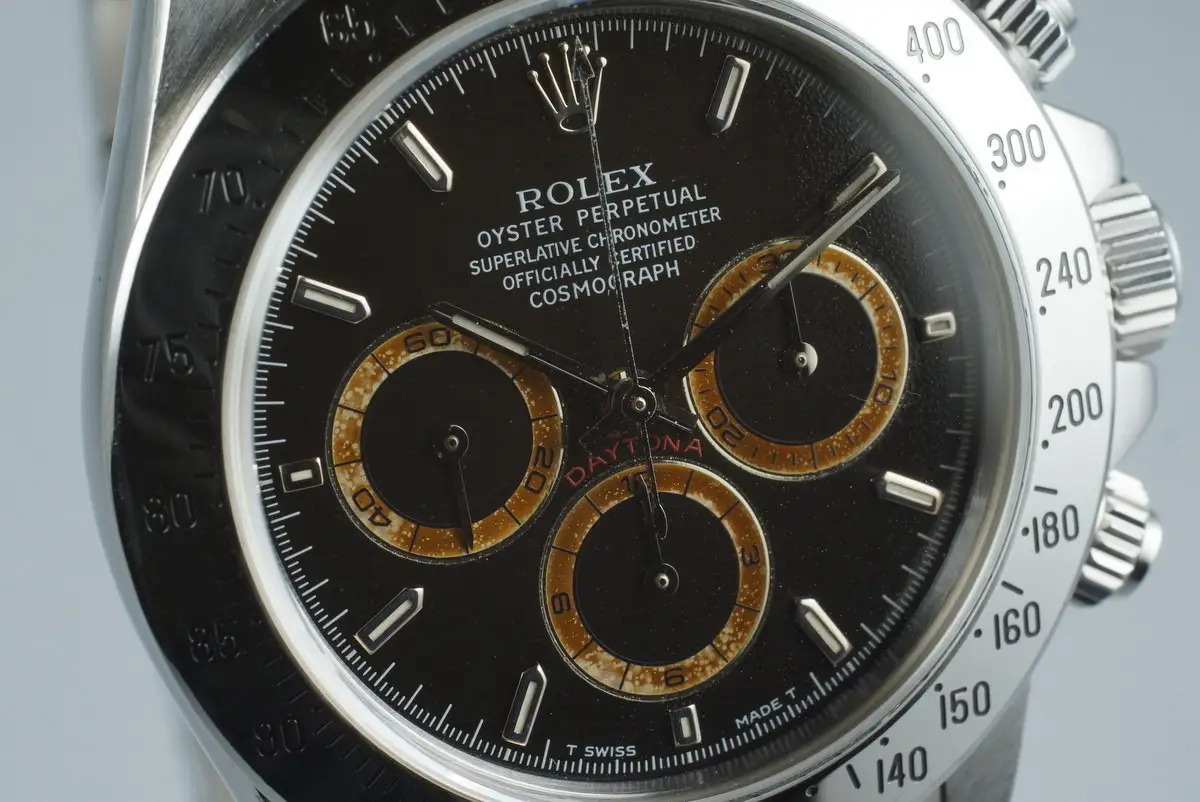Rolex Patrizzi Dial has captured the attention of watch enthusiasts and collectors alike.
This unique and aesthetically pleasing feature can only be found on some Rolex Daytona reference 16520 models, also known as “Zenith Daytonas.”
Essentially, a Patrizzi Dial denotes the natural aging and patina that occurs on the dial. Specifically, the chronograph counters transform from their original white color to an array of shades, ranging from beige to brown.
The intriguing patina effect results from the use of an organic transparent varnish called “Zappon,” adding to the watch’s appeal and value.
Rolex’s Daytona watches have always been synonymous with precision and durability. However, their so-called “flaw” – the Rolex Patrizzi Dial – has become a distinguishing characteristic that separates the Daytona reference 16520 models from their counterparts.
As we explore the world of Rolex timepieces, it’s essential to understand how this distinct dial emerged and how it remains a defining factor in the market for collectors and enthusiasts seeking a one-of-a-kind Rolex watch.
Key Takeaways
- The Rolex Patrizzi Dial can be found on some Daytona reference 16520 models and signifies the aging and patina on the watch’s counters.
- The unique patina effect results from the use of an organic transparent varnish called “Zappon.”
- The Patrizzi Dial has become a distinguishing characteristic, boosting the value and desirability of the Rolex Daytona reference 16520 for collectors and watch enthusiasts.
What is a Rolex Patrizzi Dial?
The Patrizzi Dial is a specific type of dial found only in some Rolex Daytona watches with the reference number 16520. It is also known as the “Zenith Daytona”.
This distinct dial is characterized by the aging process, or patina, that causes the counters on the dial to turn brown over time.
Originally, the counters of the Rolex Daytona 16520 were black. Rolex applied an organic varnish called Zapon to the dial. However, this resulted in inadequate protection for some models.
Consequently, the silver outer tracks of the sub-dials would oxidize, leading to the brown appearance.
However, not all Daytona 16520 watches exhibit this aging process. Among the five “marks” or dial iterations of the 16520, only the Mark IVs, produced between 1994 and 1995, develop into Patrizzi dials. Additionally, it only occurs on the black dials.
The name “Patrizzi” originates from Osvaldo Patrizzi, an Italian auctioneer and founder of Antiquorum, a prominent auction house specializing in watches. In 2005, Patrizzi discovered the unique aging of the counters while selling a 16520 at auction and identified the patina on the counters.
Due to their rarity, Patrizzi dial Daytonas command high prices in the secondary market, significantly more than their non-aged counterparts.
The aging process will continue over the years, resulting in various appearances of the Patrizzi dial depending on usage and exposure conditions.
Collectors and enthusiasts find the unintended dial defects to be more appealing. Although not initially intended by Rolex, these “mistakes” have subsequently become sought-after and collectible timepieces.
Another example of such an occurrence is the Explorer II 16550 “cream dial”, in which the originally white dial turned into a cream color over time.

